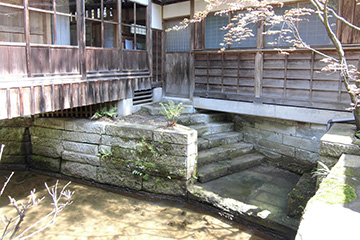Shibata river flows in the center of its site area of 1,500 tsubo (approx. 5,000 m2) and there used to be timber transported in the form of rafts up until early Showa era, creating a peaceful atmosphere. The garden is an architecture of early Meiji-era, characterized by a stunning rock work with a waterfall in the center. The Main building and the Detached room located across the Shibata river are connected by a connecting corridor. In addition, Tea room is located at the back of the garden and a bridge runs across the river, creating a circuit style path around them.

There is a mountain, an interesting mountain,
there is a waterfall, an interesting waterfall,
that I see in the garden.
This haiku, titled “upon observing the garden of Sekisensou,” was written by the first town mayor of Shibata, Kohei Hara (also a well-known poet) when he visited this place in 1921 when he was 84 years old.
This place used to be a place for retainers of Shibata Domain to practice equestrian skill and archery during the feudal government period and it has been said that the road in front of the gate is its traces. Nearby the Sekisensou is “Shimizutani palace” (currently, Shimizuen garden), which used to be a Daimyo villa of Shibata Domain and shows you a part of history of city of Shibata.

The Detached room built on the opposite side of the residential section across the river
There used to be a Japanese-style restaurant called “Hanabishi,” but it was lost in a fire in June 1904. Although it had been operating by relocating and reconstructing the current building, it moved to another place after a short time. Its ownership had shifted to the Ishizaki family, who had been running an oil refinery in city of Niitsu and had been used as a secondary residence after that.

This building, now known as the Tea room, used to be a retirement house of a doctor who served the Shibata Domain and it is said that it had been relocated from a different place during the Sino-Japanese War. The mud wall of the time lets you notice the history of the building.

Shibata river flowing in the center of the garden. It creates a very unusual scenery where a public river flows within a private land.
It is said that timber used to be transported by building a raft with timber and floating it down the river until early Showa-era.

A Stone bridge was used back in the day to move between buildings since there was no connecting corridor between the residential section and the Detached room.
As time goes on and the role of the Stone bridge has finished since a connecting corridor was built, but it is still existing there.

The sound of the Waterfall comfortably fills the garden.
It has been said that the water of the river had been flowing down and turned into the water of the Waterfall.

They are stairs to go down to the riverside called Kawato. Although there were several Kawato in the periphery, most of them have been removed.
The Kawato of Sekisensou has been left as it was in the past.

With this plan, you can charter "Sekisensou," a registered tangible cultural property as well as "Sekisensou garden," a registered monument for one day, one group exclusively and experience Japanese culture.
Plan detail© 2023 Sekisensou All rights reserved.